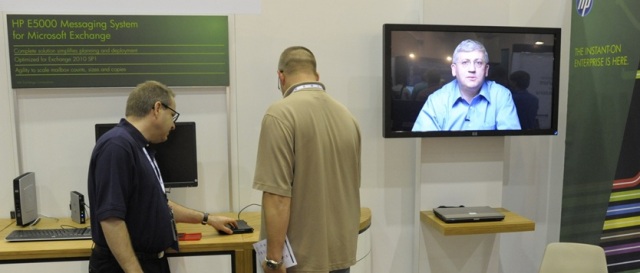Last February, Paul Robichaux, Brian Desmond and I were invited by HP to come to Cupertino to look over the HP E5000 messaging system. Over two days we had the chance to quiz Dean Steadman, the HP product manager, and Jeff Mealiffe, from the Exchange development group (Jeff specializes in topics such as performance and scalability), about how HP and Microsoft had worked together to build the first appliance-like server for Exchange 2010, aka “DAG in a box”. You can read all about the E5000 plus how we went about making some videos in this post. In any case, HP has now released a series of six videos that they have produced from the raw footage that they shot in February. It’s taken a long time to create these masterpieces, a delay that is surely accounted for by the need to make Paul, Brian, and myself look pretty. Or at least, prettier than we are in real life. This was a real challenge for some, despite the best effort of a professional make-up artist.
The six videos are:
- Introduction to HP E5000 Hardware, a walk through of the hardware engineering that’s incorporated into the E5000 to make it as resilient as possible.
- HP E5000: Complete and Optimized: a roundtable discussion of why HP and Microsoft felt that the time was right to build an appliance for Exchange and how the two companies collaborated to make the E5000 happen.
- HP E5000: Simple and Cost Efficient, describing the support setup for the E5000 (essentially, HP is the single point of contact for the hardware, Windows, and Exchange 2010).
- HP E5000: Resilient/Highly Available, figuring out whether it’s possible to really build an appliance for a Windows server appliance like Exchange that still needs some tender loving care.
- HP E5000: Large Low Cost Mailboxes. A roundtable discussion about whether people really need more than a standard 100MB mailbox (it was good enough for my father, it should be good enough for me…)
- HP E5000: Installation & Startup, looking at how the E5000 is configured, including the wizard that HP has built to remove as much of the mundane processing as possible and make installations really easy.
Apart from the MVP series, HP has released other videos about the E5000. I thought that the one featuring Dean Steadman, the product manager for the E5000, was reasonably interesting. There are other more marketing-like videos available on YouTube. HP has also used selected cuts from the videos at events such as Spring Connections in Orlando, when I had the opportunity to see myself frighten away many attendees who ventured near the HP stand. Such is life.
Have fun with the videos!
– Tony




Pingback: HP E5000 Videos Posted : Brian Desmond's Blog
It looks interesting and it may make sense to purchase for Exchange 2010 on non-virtual environment. However, this really isn’t for running Exchange 2010 in virtual environment. Especially that Exchange 2010 DAG feature is supported with features like hypervisor-based clustering, high availability, or migration solutions that will move or automatically failover mailbox servers that are members of a DAG between clustered root servers.
I agree that the E5000 isn’t intended as a good choice to run Exchange 2010 on a virtual platform. But that’s not what the design point was when HP and Microsoft set out to build an appliance to run Exchange. The beauty of the E5000 is that it brings everything together in a well-engineered package that provides a DAG in the box ready-to-go for deployment. You can certainly use an E5000 to run Hyper-V or VMware, but that’s not its core purpose nor is it the best way to get value from the box.
TR